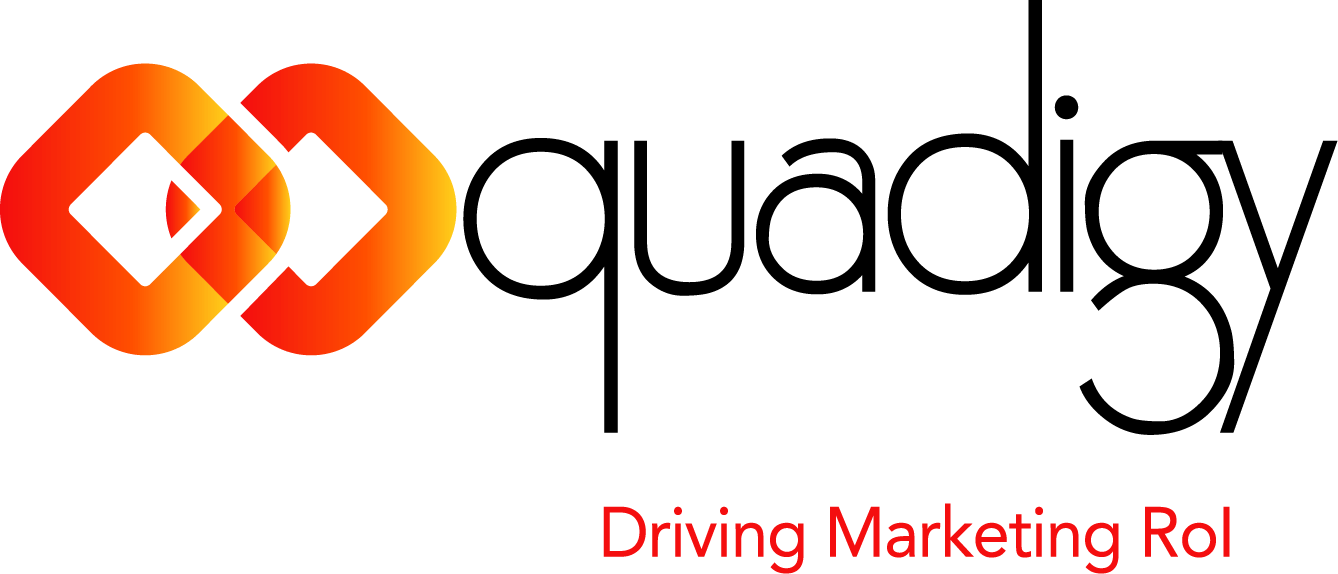Introduction: The Art of Conversion
In the digital marketing realm, the conversion funnel is a fundamental concept, and landing pages are its linchpin. These pages are more than just a destination for visitors arriving from ads or referrals; they are meticulously designed environments crafted to transform interest into action. This transformation is the essence of conversion optimization. This landing page guide is your gateway to mastering the art of converting clicks into conversions.
Mastering this art involves a deep understanding of several key factors: the target audience, the principles of persuasive design, the craft of compelling copywriting, and the technical aspects that ensure the page is accessible and performs swiftly. This guide aims to delve into these elements, offering insights and landing page optimization tips for optimizing landing pages. By honing this craft, businesses can significantly enhance their chances of turning casual clicks into valuable conversions, ultimately driving success in the digital era.
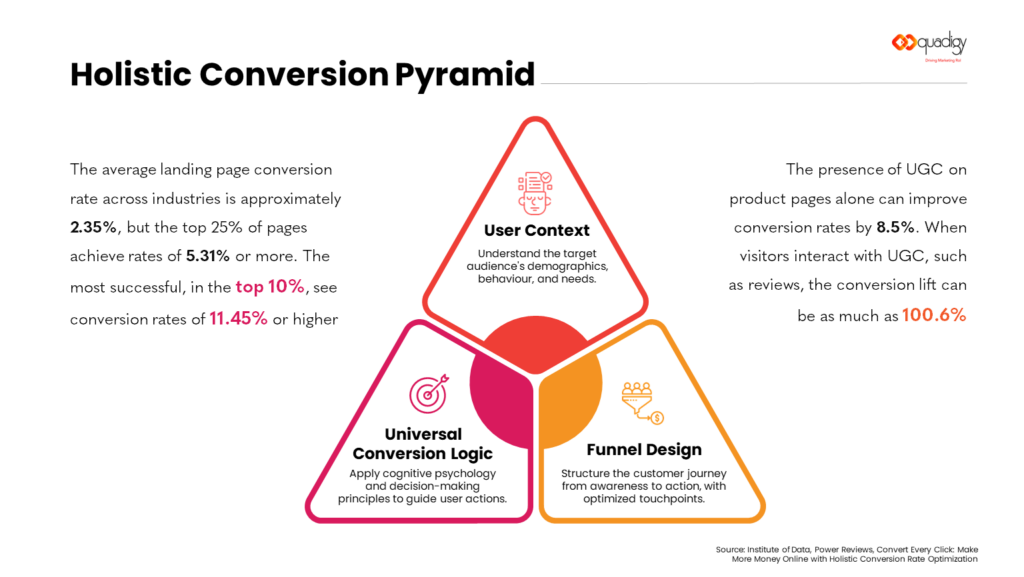
Knowing Your Audience: The First Step to Conversion
The effectiveness of a landing page is deeply rooted in how well it aligns with the needs, preferences, and behaviors of its intended audience. Understanding your target audience is not just a step in the process; it is the cornerstone of creating a successful landing page strategy.
To start, it’s crucial to develop detailed audience personas. These personas are semi-fictional representations of your ideal customers, based on real data and some educated speculation about demographics, behavior patterns, motivations, and goals. They should include details like age, gender, occupation, interests, and any other relevant characteristics. These personas help in visualizing who you are talking to, making your messages more personal and relevant.
Next, dive into the behavioral patterns of your audience. Where do they spend their time online? What type of content do they engage with most? Are they more responsive to visuals or text? Platforms like Google Analytics can provide insights into the online habits of your audience, helping you tailor your landing page accordingly.
Understanding the motivation behind your audience’s actions is also key. Are they looking to solve a specific problem? Are they seeking to improve something in their personal or professional lives? By identifying these motivations, you can align your landing page’s messaging and design to tap into these driving factors.
Finally, consider the pain points and challenges your audience faces. Your landing page should not only highlight the features of your product or service but also frame them as solutions to these specific challenges. This approach ensures that the content resonates with the audience, addressing their needs and interests directly, thus increasing the likelihood of conversion.
By thoroughly understanding your audience, you can create a more relevant, engaging, and effective landing page that speaks directly to their desires and needs, ultimately paving the way for higher conversion rates.
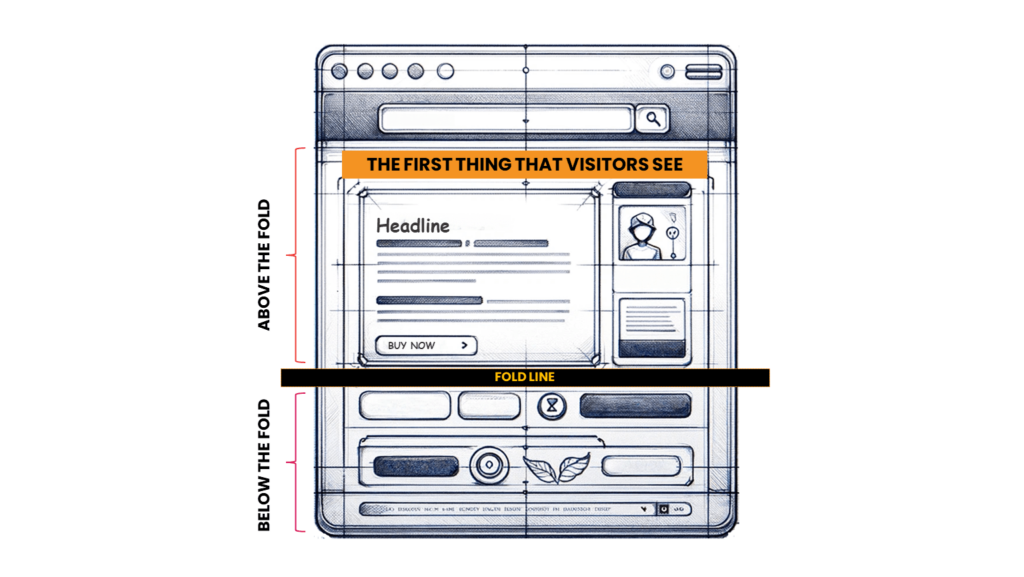
The Power of the First Impression: Landing Page Aesthetics
The aesthetic appeal of a landing page plays a pivotal role in making a powerful first impression. This initial impact can significantly influence a visitor’s perception of your brand and their decision to engage further.
- Design for Clarity and Focus: The primary objective of your landing page design should be to guide visitors towards the intended action, whether it’s signing up, making a purchase, or downloading a resource. To achieve this, the layout should be clean and uncluttered. Avoid overwhelming visitors with too much information or too many visuals. A minimalist approach, with ample white space, helps in focusing the visitor’s attention on the key elements of the page.
- Use of Visual Elements: An engaging hero image or video at the top of the page can be very effective in capturing attention. This visual should be relevant and align with the overall message of the page. Consistent and appealing color schemes, high-quality images, and professional-looking graphics can also enhance the visual appeal and credibility of the landing page.
- Typography and Readability: The choice of fonts and text layout is crucial. Use fonts that are easy to read and keep the font size and line spacing optimized for readability. Headlines should stand out and be compelling, while the body text should be easily scannable.
- Brand Consistency: Ensure that the design elements align with your brand identity. Consistent use of colors, logos, and stylistic elements across all marketing materials helps in building brand recognition and trust.
- Strategic Visual Hierarchy: Arrange elements in a way that naturally guides visitors through the content, towards the call-to-action (CTA). Important elements like CTAs and key benefits should be prominent and positioned where they are most likely to catch the visitor’s eye.
- Eliminate Distractions: Remove any elements that do not contribute to the goal of the page. Extraneous links, unnecessary information, or too many options can distract visitors from the main conversion goal.
Common pitfalls to avoid with landing pages.
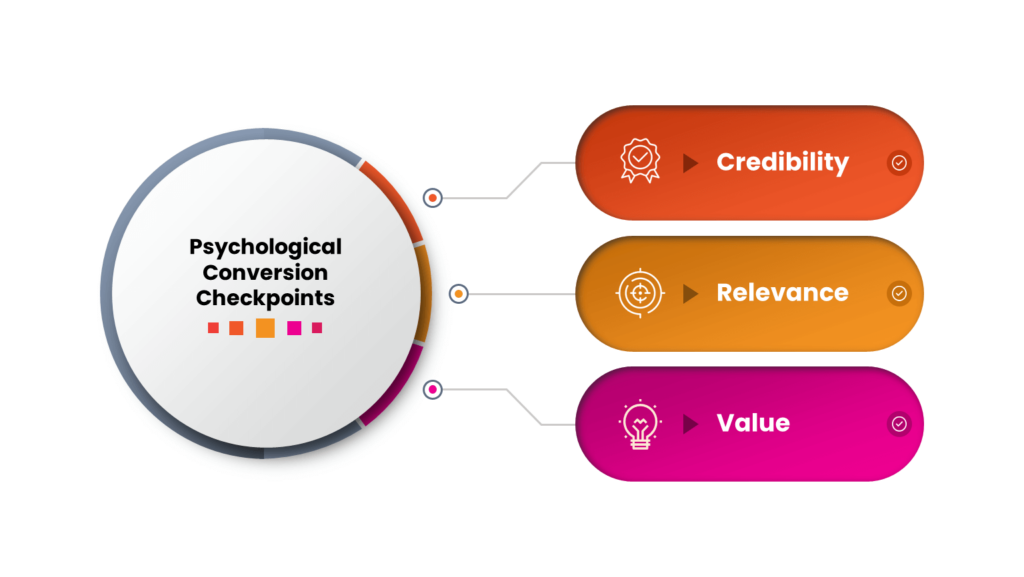
Content that Connects: Crafting Compelling Copy
The content on your landing page is a critical factor in engaging visitors and driving conversions. It’s not just what you say, but how you say it. Compelling copy resonates with your audience, addressing their needs and motivations, and ultimately persuading them to take action.
- Understand and Speak to Your Audience: Your copy should reflect a deep understanding of your audience’s needs, desires, and pain points. Use the insights from your audience research to craft messages that speak directly to them. The tone should be conversational, creating a feeling of one-to-one communication.
- Powerful Headlines and Subheadings: The headline is often the first thing visitors see and can make or break their decision to stay on the page. It should be attention-grabbing, clear, and relevant. Subheadings should further intrigue the reader, breaking down the content into digestible sections.
- Benefits over Features: While listing the features of your product or service is important, translating these features into benefits is what truly connects with the audience. Show how your offering solves a problem or improves their situation.
- Clear and Persuasive Call-to-Action (CTA): Your CTA is where you directly ask the visitor to take the next step. It should be clear, compelling, and convey a sense of urgency or value. Avoid vague language; instead, use action-oriented phrases that prompt immediate response.
- Addressing Objections: Anticipate any potential objections or hesitations your visitors might have and address them in your copy. This can build trust and remove barriers to conversion.
- Storytelling: People connect with stories. If applicable, use storytelling to make your offering more relatable and memorable. This can be through customer testimonials, case studies, or a narrative about the product or service.
- Keep It Focused and Concise: Every word on your landing page should serve a purpose. Be concise and stay focused on guiding the visitor towards the conversion goal. Avoid extraneous information that could distract or confuse.
Calls-to-Action that Compel
The Call-to-Action (CTA) is a pivotal element of your landing page, serving as the tipping point between visitor interest and actionable response. Crafting effective CTAs is both an art and a science, requiring a strategic approach to design and wording.
- Strategic Placement: Position your CTAs where they are most likely to catch attention and inspire action. Common placements include above the fold (the portion of the webpage visible without scrolling), at the end of key sections, and as a floating button that follows as the user scrolls.
- Design for Visibility: Your CTA buttons should stand out from the rest of the page. Use contrasting colors and sufficient size to make them easily noticeable. However, ensure that the colors align with your brand palette to maintain consistency.
- Action-Oriented Language: The text on your CTA buttons should inspire action. Use verbs and phrases that convey a sense of immediacy and benefit, such as “Get Started,” “Learn More,” or “Claim Your Free Trial.” Avoid generic phrases like “Click Here,” which are less compelling and informative.
- Simplicity in Forms: If your CTA involves filling out a form, keep it simple and straightforward. Request only the essential information to reduce friction and prevent abandonment. The easier it is to complete, the higher the likelihood of conversion.
- Multiple CTAs for Different Segments: Consider using different CTAs that cater to various segments of your audience. For instance, new visitors might respond better to a “Learn More” CTA, while returning visitors might be more inclined to “Buy Now” or “Join Today.”
- Utilizing Social Proof: Incorporating elements of social proof, like “Join 5,000+ satisfied customers,” can enhance the effectiveness of your CTA. It leverages the power of community and trust, encouraging visitors to join the ranks of other satisfied users.
- Testing and Optimization: Continuously test different CTA elements, including wording, color, placement, and size. Use A/B testing to determine which variations yield the highest conversion rates. This data-driven approach ensures that your CTAs are always optimized for maximum impact.
A well-crafted CTA is the culmination of your landing page’s persuasive efforts. It’s the final nudge that converts a visitor into a lead or customer. Paying careful attention to its design, placement, and messaging can significantly impact the overall effectiveness of your landing page.
Speed as a Conversion Factor: Page Load Optimization
The loading speed of your landing page is a critical factor in retaining visitor interest and maximizing conversion optimization. In an age where users expect instant access to information, even a slight delay can lead to increased bounce rates and lost opportunities. The importance of page speed cannot be overstated in this context.
- Image Optimization: Large images are one of the main culprits for slow loading times. Optimize images by compressing them and using appropriate file formats like JPEG for photographs and PNG for graphics with transparent backgrounds. Consider using modern formats like WebP, which provides high-quality results with smaller file sizes.
- Minimize Use of Heavy Scripts and Plugins: Excessive use of JavaScript and third-party plugins can significantly slow down your page. Evaluate the necessity of each script and plugin, removing or replacing those that are not essential or are performance heavy.
- Utilize Browser Caching: Browser caching stores certain elements of your website on the visitor’s device so that they don’t have to be reloaded with each visit. This can drastically reduce load times for repeat visitors.
- Content Delivery Network (CDN): A CDN can distribute your content across multiple servers around the world. This means that users can load your landing page from a server that is closer to them, reducing load times.
- Responsive Design: Ensure that your landing page is designed responsively. This means it adjusts content and image sizes based on the user’s device, which is particularly important for mobile users.
- Optimize CSS and HTML: Minifying and combining CSS and HTML files can reduce the number of requests made by the browser, thereby speeding up the load time. Inline your critical CSS and defer non-critical CSS.
- Performance Budgets: Establish performance budgets for your page. This means setting targets for the size of your page (in kilobytes) and adhering to them during the design and development process.
- Regular Speed Testing: Regularly test your landing page’s speed using tools like Google PageSpeed Insights, GTmetrix, or Pingdom. Monitor how changes to your page affect its performance and react accordingly.
Mobile Optimization: Catering to the On-the-Go User
With the increasing prevalence of smartphones and tablets, mobile optimization is no longer optional; it’s a necessity. A landing page that isn’t optimized for mobile users can lead to poor user experience, negatively impacting your conversion optimization.
- Responsive Design: Ensure that your landing page design is responsive. This means the layout should automatically adjust to fit the screen size of the device being used. Text should be readable, images should resize appropriately, and interactive elements like buttons should be easy to tap.
- Touch-Friendly Navigation: Considering the touch-based interface of mobile devices, make sure that clickable elements are easily accessible and large enough to be tapped without zooming. Spacing around links and buttons is also important to prevent accidental clicks.
- Speed Optimization: Mobile users often have slower internet connections, so optimizing for speed is crucial. This includes compressing images, leveraging browser caching, and minimizing the use of heavy scripts.
- Simplified Content and Layout: On smaller screens, space is at a premium. Simplify your content and layout to focus on the most critical elements. Long paragraphs of text can be daunting on mobile, so use bullet points and short, concise messaging.
- Testing on Multiple Devices: Test your landing page across a range of mobile devices to ensure compatibility and performance. This includes checking different screen sizes, operating systems, and browsers.
- Mobile Load Speed Testing: Regularly test your page’s load speed on mobile devices using tools like Google’s Mobile-Friendly Test. This not only checks speed but also evaluates mobile usability.
- Minimize Form Fields: If your CTA involves filling out a form, minimize the number of fields required to reduce friction for mobile users. Typing on a small screen can be cumbersome, so ask only for essential information.
- Avoid Pop-Ups: Pop-ups can be particularly intrusive and frustrating on mobile devices, often leading to higher bounce rates. If they are necessary, ensure they are easy to close and don’t hinder the user experience.
By prioritizing mobile optimization, you cater to a significant portion of your audience who will access your landing page on-the-go. This approach not only enhances user experience but also contributes positively to conversion rates and overall digital strategy success.
SEO Best Practices: Being Found is Half the Battle
Effective Search Engine Optimization (SEO) is crucial for ensuring your landing page is easily discoverable by your target audience. Implementing SEO best practices can significantly increase the visibility of your page in search engine results, driving more qualified traffic to it.
- Keyword Research: Begin with thorough keyword research. Identify the terms and phrases your target audience uses when searching for solutions or information related to your product or service. Utilize tools like Google Keyword Planner, Ahrefs, or SEMrush for this research.
- Incorporate Keywords Strategically: Once you have identified your keywords, integrate them into your landing page This includes placing them in key areas like the title tag, headings, the main body of the text, and the meta description. However, avoid keyword stuffing, as this can negatively impact your SEO efforts.
- Optimize Page URLs: Create clear, concise URLs for your landing pages. Include relevant keywords and ensure they are user-friendly. A well-structured URL not only aids in SEO but also helps users understand what the page is about.
- Meta Descriptions and Title Tags: Craft compelling meta descriptions and title tags. They should include your primary keywords and provide a clear, concise summary of your page’s content. This is often the first thing users see in search results, so make it count.
- Mobile-Friendly Design: With Google’s mobile-first indexing, having a mobile-friendly landing page is essential for SEO. Ensure your page performs well on mobile devices in terms of layout, load time, and usability.
- Loading Speed: Page speed is a ranking factor for Google. Optimize your landing page’s loading time by compressing images, minifying code, and leveraging browser caching.
- Quality Content: Create high-quality, relevant content that addresses the needs and interests of your target audience. Engaging and valuable content can improve dwell time, reduce bounce rate, and enhance the overall SEO performance of your page.
- Build Backlinks: High-quality backlinks from reputable websites can significantly boost your page’s search engine ranking. Focus on building relationships with industry influencers, guest blogging, and creating shareable content to attract backlinks.
- Regular SEO Audits: Continuously monitor and update your SEO strategy. Regular audits can help identify areas for improvement, ensuring that your landing page remains optimized for the best search engine performance.
By implementing these SEO best practices, your landing page stands a better chance of ranking higher in search results, attracting more traffic, and consequently, achieving higher conversion rates.
Trust Building: Leveraging Social Proof and Security
Building trust is essential in converting visitors into customers. Leveraging social proof and showcasing security measures can significantly enhance the credibility of your landing page, making visitors more comfortable in taking the desired action.
- Social Proof: Social proof is the concept where people are influenced by the actions and approvals of others. Include elements like customer testimonials, user reviews, and case studies on your landing page. Highlighting positive experiences from other customers can significantly influence decision-making.
- Use of Trust Badges: Display trust badges to convey security and reliability. This can include badges for secure checkout, SSL certificates, and endorsements from well-known brands or industry bodies. These badges provide reassurance that the visitor’s data is safe and that your business is credible.
- Showcasing Awards and Recognitions: If your product or service has received any awards or recognitions, make sure to display them prominently. This further establishes your brand’s authority and trustworthiness in your industry.
- Customer Counts and Success Stories: Sharing the number of customers served or success stories can be a powerful indicator of your product’s effectiveness and popularity. It can also create a sense of FOMO (fear of missing out), encouraging visitors to join the ranks of satisfied users.
- Real-Time Activity or Usage Stats: Showing real-time statistics, like the number of current users online or recent purchases, can add a sense of liveliness and trustworthiness to your page.
- Clear Contact Information: Providing clear and easy ways to contact your business adds a layer of trust. It reassures visitors that they can reach out if they need support or have questions.
- Transparency in Policies: Be transparent with your policies, including returns, refunds, privacy, and terms of service. Making these policies easily accessible helps build trust by showing that you have clear guidelines and procedures in place.
- Leverage Influencer Endorsements: If possible, use endorsements from industry influencers or celebrities. An endorsement from a respected figure can significantly boost the credibility of your product or service.
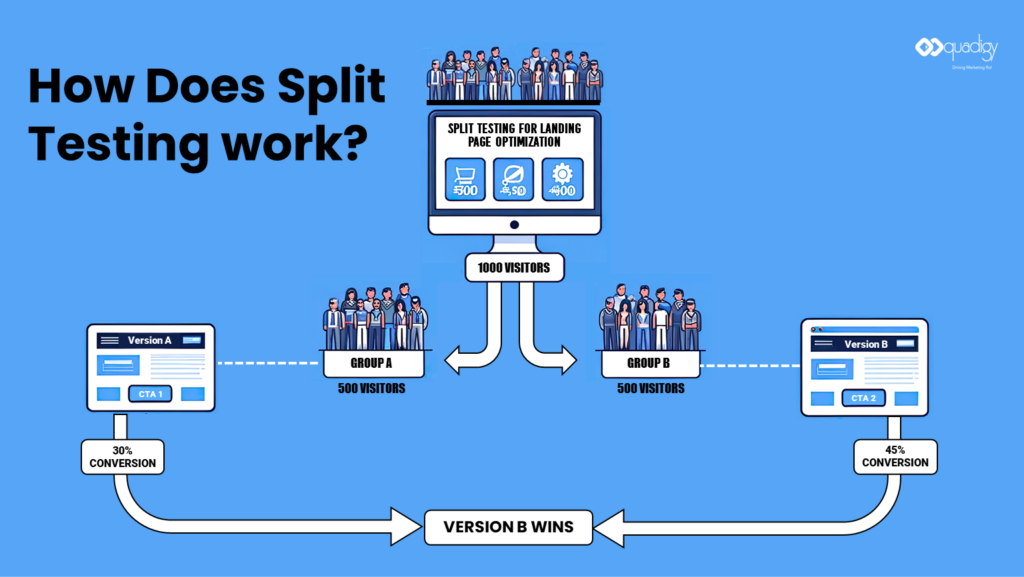
Analytics and Adaptation: Measuring for Success
Utilizing analytics and continuously adapting your landing page based on data-driven insights is crucial for maximizing its effectiveness. By understanding and analyzing user behavior and conversion optimization metrics, you can make informed decisions to optimize your landing page strategies for better performance.
- Set Up Key Performance Indicators (KPIs): Identify what metrics are most important for your landing page. Common KPIs include conversion rate, bounce rate, traffic sources, average time on page, and form submission rates. These metrics provide insight into how well your page is performing and where there is room for improvement.
- Use Analytics Tools: Tools like Google Analytics can provide a wealth of information about your landing page’s They help you track visitor behavior, source of traffic, engagement levels, and conversions.
- A/B Testing: Implement A/B testing (split testing) to compare different versions of your landing page. You can test various elements like headlines, CTAs, images, layouts, and content to see which variations perform the best.
- User Feedback and Surveys: Sometimes, direct feedback from users can provide invaluable insights. Use surveys or feedback tools to gather opinions about what users like or dislike about your landing page, and what might prevent them from converting.
- Heatmaps and User Session Recordings: Tools that provide heatmaps and session recordings can offer a visual understanding of how users interact with your page. This can reveal which areas attract the most attention and where users drop off.
- Regularly Review and Adapt: Digital trends and user preferences can change rapidly. Regularly review your landing page performance and stay open to making necessary adjustments. This could mean updating your content, changing your design, or refining your SEO best practices.
- Mobile Performance: Given the importance of mobile traffic, monitor how your landing page performs on mobile devices specifically. This includes load times, mobile user engagement, and conversion rates.
- Competitor Benchmarking: Keep an eye on your competitors. Understanding what they are doing can provide valuable insights and help you identify opportunities for improvement.
By continuously measuring, analyzing, and adapting your landing page based on concrete data, you can incrementally improve its performance, leading to higher conversion rates and a better return on investment.
Conclusion: Evolving with the Digital Landscape
Landing page optimization is an ongoing process, necessitating continuous adaptation and learning in the dynamic digital landscape. Keeping abreast of the latest trends, tools, and best practices in digital marketing and user experience is crucial. Experimentation and innovation play a key role, inviting opportunities to integrate emerging technologies and fresh design trends. Watching competitors and industry leaders can provide valuable insights and inspiration.
Responding to user feedback and behaviors is essential for maintaining relevance and high conversion rates. Optimizing for a variety of platforms and devices, including emerging technologies, ensures broad accessibility and engagement. A data-driven approach should guide these efforts, with regular analysis informing iterative improvements. Agility and responsiveness to market changes are vital, reflecting the need for a landing page strategy that is not only effective but also adaptable to the ever-changing digital environment.
Maximize your landing page impact with our expert guidance. Contact Us Now for tailored solutions that turn clicks into conversions. Start your journey to digital marketing success today!
